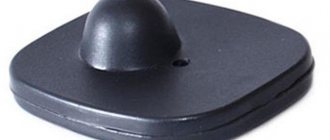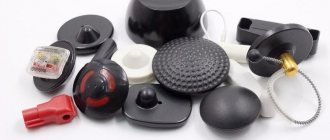What is an anti-theft sensor
This device is familiar to most buyers. We are talking about those same plastic devices attached to clothing that from time to time put even law-abiding citizens in an awkward position. This happens when salespeople forget to demagnetize the device before the customer leaves the store. In such a situation, the output frames sound the alarm with a loud sound and bright light signal.
Emergency warning systems (EWS) consist of 3 components:
- sensors;
- gates with built-in radio antennas (located at the exit from the store);
- control unit.
Inside each security sensor there is a resonator - a device that picks up the transmitted signal and repeats it. The radio antenna also contains a receiver programmed to recognize. SES devices signal if clothing with a sensor attached or not deactivated is carried through the “gate”.
Go to the store for help
So, let's start telling you how to remove magnetic locks from clothes. The easiest way is to return to the store, no matter how far it is from your home. Just don't forget to bring your purchase receipt with you. Otherwise, trouble is possible - the likelihood that the sellers remember your face is not so high, and therefore accusations of theft may fall, and it will come to calling the police. It is not a fact that every store has cameras that could record your honest purchase. And by the time your relatives bring the check, a lot of time and unpleasant minutes will pass. By the way, this is another reason to pick up checks and keep them for a certain time.
If the store is too far from your home and you don’t want to return to it at all, then there is another option, how to remove magnetic locks from clothes
. It will also require the involvement of third parties. Go with the purchased product to the store closest to your home and ask the sales consultants to solve the problem. Fortunately, systems that remove the lock from a magnetic lock are now installed in almost all stores, especially large ones. Again, don't forget to take your receipt with you. This will protect you from unfounded suspicions and unnecessary troubles.
History of anti-theft systems
The products first appeared on the market in 1966. Today, security sensors have become so popular that annual revenue from the sale of devices amounts to billions of dollars.
For the first 20 years of anti-theft devices' existence, radio frequency technology was used. A semiconductor diode was used to relay the high-frequency radio signal from the detection antennas. In most cases, the alarm was triggered, but the capabilities of this technique were still limited. For example, older devices could be defeated by placing goods in a foil bag, which blocked the signal. In addition, due to the widely spaced entrance gates, false alarms occurred.
In the mid-80s of the last century, acoustomagnetic technology was developed. These emergency alert systems work with low-frequency radio waves that cannot be blocked by metal foil. The sensors contain coils of suitably magnetized metal that resonate in response to a signal. Although these types of systems are slightly more expensive than their predecessors, the cost is recouped through reliable operation.
Anti-theft sensors are standard security in most clothing stores. In the past, appliances were large and bulky, as were the pins that could easily damage the fabric, leaving holes in the material. Modern devices are designed in such a way that coupling and detaching are carried out delicately, without causing damage to clothing.
Safety precautions when removing at home
When removing the magnetic sensor yourself, it is worth remembering the following precautions:
- The sensors must be removed with extreme caution so as not to damage the product.
- You should not try to tear off the protection.
- Capsules with dye can ruin the item forever.
- You can only set fire to the protection in a well-ventilated area or outdoors.
Despite the various ways to remove a clip at home, it is better to use a magnet installed in a store. This way the product will definitely remain safe and sound. Removing magnetic protection at home should be done with extreme caution. And in the future, it is better to once again ask the seller to check whether all the protective clips have been removed.
Source
Production technology of anti-theft devices
Anti-theft devices consist of three main components:
- a sensor that is connected to an emergency warning system through a certain type of signal;
- pins or magnet;
- locking mechanism.
Reusable rigid devices, which are most often used to protect textile products, are made of impact-resistant plastic. The pin for attaching the device to the product is made of nickel-plated steel.
The plastic body is cast by vacuum molding or under pressure. The resonator is a coil of insulated copper wire, the ends of which are connected through a diode. After the resonator is inserted into the plastic housing, the locking mechanism is installed. It usually consists of a coupling that secures a metal pin.
Once the resonator and coupling assemblies are in place, the top and bottom parts of the housing are joined together. They are sealed by heating or welded ultrasonically
Boomerang effect or use a magnet against the “magnet”
The next method is how to remove magnetic locks from clothes
, will be virtually identical to what is used in stores. Again, find the face of the lock and the bulge on it that we tried to pick out earlier, and apply a powerful magnet to it. The cylinder will be pulled towards the magnet and press on the spring, which will allow you to get rid of the lock. But the magnet used for these purposes must really be powerful enough, since the cylinder is relatively heavy and it is not so easy to set it in motion. Especially if you decide to use the first magnet you come across, which is a souvenir item attached to the refrigerator. But a DC electromagnet will certainly help you.
By the way, an AC electromagnet used in a compressor that supplies oxygen to the aquarium can come to the rescue. However, first you will have to “break” it a little - remove the end plate, exposing the W-shaped core. Now again determine which side of the lock the bulge is on and bring it to the core. The magnet causes the lock to vibrate, pulling and releasing the cylinder and spring. All you have to do is guess the moment when the cylinder begins to put pressure on the spring and remove the plate blocking the lock.
We hope that from the variety of ways to remove magnetic locks from clothes
, you will still find the one most suitable for you. Good luck fighting the castle and be careful when purchasing goods. This will save you from having to cheat in order to remove the lock.
Types of anti-theft sensors
Anti-theft sensors for preventing clothing theft in stores come in several types: rigid plastic and flexible self-adhesive tags. The latter are glued to places where they are difficult to detect: under the collar of a jacket, lapels, and so on.
There are devices on the SEA market that are compatible with radio frequency and acoustomagnetic systems.
Clothing is usually protected with rigid sensors of varying levels of reliability. Such products come in various geometric shapes and differ in fastening mechanisms. The locking component determines how easy it is to disconnect and remove the sensor. It can be magnetic or mechanical.
Magnetic devices come in the following classes:
- Standard strength. This option was used in previously manufactured security systems. The mechanism has a low degree of protection.
- With a powerful magnet, the strength of which is more than twice that of standard ones. Sensors of this class provide increased safety.
- Devices whose design uses a combination of several powerful magnets. Such mechanisms are classified as the highest protection class. The added security comes from the fact that it is difficult for a would-be criminal to make and carry a puller for this type of appliance.
Hard button sensors, which are attached to products using pins and magnets, can only be removed using a special tool. These devices are reusable. Such a device is difficult to hack without damaging a piece of clothing. Models in the high price segment signal if an attempt is made to remove the sensor from the product.
Over the years, a number of options have been developed to improve security effectiveness. For example, ink tags contain small vials of dye. If the tag is forcibly removed from the clothing, it will break. The resulting ink leak not only ruins clothing, but also leaves stains on the thief's hands, making identification easier.
Some anti-theft sensors, in the form of flexible labels, are so small that they can be hidden in a seam of clothing during production. The next generation of security sensors will contain smart chips.
Step-by-step instructions for removing the magnet
To answer the question of how to disconnect the device at home, you must follow the step-by-step instructions. It lists all the points intended to be completed. By following them, property damage will not occur.
There are several options for removing magnets from clothes at home. Everyone chooses what is suitable for themselves. For example, instructions for cutting the tip of a magnetic device:
- take the tag in your left hand, and a sharp knife or hacksaw blade in your right hand;
- cutting of the product begins;
- Carefully separate the tip and remove the core.
To remove clothing magnets, use a standard candle. To do this, you need to light it and bring it to the device. If a large hole appears, try to get the contents out, remove all parts, and separate the tag into two parts.
Another method for removing a tag from a product is to use a gas stove lighter. If all points are strictly followed, the risk of damaging the goods will be reduced to a minuscule amount. Let's get started:
- The first step is to heat the lock and perform the process in a safe place.
- After the hole has been burned, remove the lighter and take a screwdriver.
- Continue work.
- Using pliers, remove the core.
- If it doesn’t lend itself well, burn it some more.
- Take out all the parts and remove the lock.
Device design
Most often, there are four types of sensors in clothing stores.
Flat "Pencil"
Such safety devices provide puncture-free fastening. The mechanism is equipped with a long lever. The clothing pin snaps into the cap so there is no need to pierce the material. These devices are ideal for preventing theft of swimsuits, scarves and underwear made from delicate materials. “Pencil” is produced with a length of about 48 mm and a diameter of about 10 mm.
Super tag sensor
A special feature of this device is a mechanical lock. The sensor can only be dismantled using a special manual or automatic removable device. It is attached to the product using a special needle with a wide plastic cap. Size 70×30 mm and 55×30 mm.
Square "Mini Squire"
A flat device with a small protruding part. The Mini Squire anti-theft sensor is designed so that this form of the device does not interfere with the buyer trying on clothes. An additional hole allows you to use a steel cord and hang the device from belt loops or other parts. This sensor is only available in RF version. Size 48x42 mm, weight about 6 g. Reliable and inexpensive.
"Shell" (golf)
Designed for more durable materials. The ultra-thin rod easily penetrates the fabric without leaving marks. Another advantage is ease of use. The “shell” fastening pin allows you to easily fix the device with one hand. When using these devices, employee productivity increases noticeably, as time spent on marking is reduced. There are 3 main sizes on the market: 45 mm, 54 mm, and 63 mm in diameter.
Variety of other options
In the case when both of the above methods of how to remove magnetic locks from clothes are irrelevant for you, you need to turn to the third. You will have to get a little angry at the magnet, imagine that you hate it even more than your own boss, grab one edge of your clothing so that the lock is on the other side, and hit the wall or floor with all your might. The essence of this method is that with a strong blow, you can activate the internal structure of the lock - in particular, a special cylinder with balls, which will press on the spring and separate both parts of the “magnet”. It’s not a fact that it will work out the first time, but with the right amount of effort, the result will come pretty soon.
The main disadvantage of the previous method is that when hitting and waving clothes, you can damage the clothes themselves. Therefore, we will tell you about another way to remove magnetic locks from clothes.
. It is an improvement on the last option. Place the clothing on a hard surface, preferably one that will not break when struck with a hammer. The main thing is to turn the “magnet” out so that as little clothing as possible remains under it. Once you have completed all the preparations, strike the magnet with the wide side of the hammer. This will allow you to break the lock. If you want to keep it safe and sound, take the “magnet” in one hand, and the hammer in the other, and deliver blows that will be much softer, but more targeted and no less effective. Three, maximum five blows will be enough to release the lock, that is, to force the cylinder to press on the springs.
And this method does not suit you? Then another option is how to remove magnetic locks from clothes. There is a small bulge on one side of the locking device. Take any sharp, reliable and strong object (for example, a carving knife) and start picking at the bulge. Be careful not to get hurt; in this case, holding the lock in your hands is not recommended. As soon as the spring comes out through the hole you made, the cylinder with balls will also be unlocked and this will allow you to remove the lock.
How to choose an anti-theft sensor
Selecting a sensor or tag to optimally protect a store's inventory depends on a number of key factors:
- type of goods sold;
- product price segment;
- existing emergency warning system at the point of sale.
From a safety point of view, round devices are more often chosen. The shape makes it difficult to separate elements from each other. The size of the needle should also be taken into account, if its presence is provided for by the design of the device. The larger its diameter, the more difficult it is to remove the sensor from clothing without damaging the integrity of the fabric.
What to do if the protection has not been removed, how to demagnetize it in a simple way?
It is optimal to return to the store with a receipt for the goods and ask the seller to remove the clip.
To do this, you will need a receipt as confirmation that the item was not stolen. The seller will remove the magazine magnet and will continue to be attentive to checking the safety sensors. But what if returning to the shopping center is not possible? If the store where the purchase was made is not nearby, you can try to contact any other store with the receipt. Practice shows that sellers are willing to accommodate and remove protection. In case of failure, the magnet will have to be removed at home.
How to properly place the sensor on clothing
The anti-theft system should not interfere with customer service. Striking a balance between the use of anti-theft sensors and quality customer service is important. The speed and efficiency of the trading process depends on this.
The first step is to properly place security tags on your clothing. Sensors should not be located where they would prevent the customer from comfortably trying on the product. A large device such as a convex or grooved “shell” should be placed outside. The flat and smooth side is on the reverse side. When the buyer puts on a piece of clothing, he will be able to easily put his hand through the sleeve without catching the device.
Another aspect to consider is the placement of the sensors in relation to the seams. If the device is attached to the seam of a shirt, the thief will cut it and remove the device. Repairing a small hole in this area is easy. Placing the sensor a few centimeters to the left or right of the seam does not pose a problem, but increases safety.
There is no need to use the same size sensor on a T-shirt as on a winter coat. It is bulky and conspicuous to the buyer. It is better to use smaller, discreet anti-theft devices. A large device is suitable for outerwear. In this case, the obviousness of the fact that the goods are protected is appropriate.
Managers of clothing stores are recommended to introduce a system of internal rules that specify where the protective sensor is placed in the product. For example, on the lower left pant leg, the right sleeve of a coat, and so on. This will make it easier for cashiers to navigate when serving the customer. If the seller has to search the entire perimeter of the garment for the sensor, his productivity will be low. It’s even worse if the cashier misses the device and causes inconvenience to the buyer in the form of subsequent proceedings.
What does an RF tag look like?
In addition to the device of the tag, you can talk about the so-called “bottle sensor”. Among RF beepers, it is widely used in retail industry. Its demand is explained by its adequate cost, ease of use, and it can be purchased without problems. The bottle tag is distinguished by its stylish appearance: two clips, one of which has a bulge that resembles a bottle. In addition, it has a different type of fastening - an adjustable cable that connects the sensor and the product.
Removing a Security Sensor
When selling a product, the hard anti-theft sensor must be removed from the product in order to be reused in the future. This process occurs using a mechanical device or a powerful magnet. The puller releases the locking mechanism and allows you to remove the safety sensor. Install it on the counter in the checkout area.
Flexible security tags are deactivated by a scanner at the time of payment to the buyer. During the deactivation process, the circuit inside the tag is broken. After this, it no longer emits a signal near the antenna and does not set off the alarm. Labels cannot be reused.
Options for removing a magnet at home
A variety of options are available. But this does not mean that if one person succeeded, then another will quickly cope with it. Everything happens at your own peril and risk. The person himself bears responsibility for the final result.
When the question arises of how to remove a magnet from clothes at home, the answer seems easy. Use the force method. Take your purchase and slam it against the wall. This option is not modern and cultural. But it will perfectly show the principle of operation of this mechanism.
What can you recommend for removing magnets from clothes?
This will let you know that the tag makers took this option into account. To protect the magnetic beeper from force, they created it using dyes. They are very durable. If the system is disrupted, all the paint will leak onto the product. The appearance will deteriorate irrevocably. There is a more humane way to remove anti-theft:
- You should place the clothes in the refrigerator for a couple of hours to freeze. The marker will harden and will not harm her.
- Wear a wide elastic band between the product and clothing. If necessary, take another one.
- You should twist the tag carefully so that the elastic can go as deep as possible.
- Continuing to rotate, try to pull the magnet until it splits into two halves.
- You can use pliers for removal. Initially, you must remember to freeze the goods well.
To understand how to open a product, you need to understand its design. It is very intricate. Its principle is the same almost everywhere. It looks like a nozzle with a metal rod. It may be a capsule containing dye inside. This paint will glow neon for a couple of days even after washing. The fixation device is packaged in a cone, which can be black or white.
Most tips use heavy, cutting or piercing tools. They carry the potential to damage the product. There is also no need to pull on the pin. This will block it more tightly. A simple option to remove a magnet from clothes at home is to:
- Press your clothing release magnet onto the tag.
- After it has demagnetized, remove the tag.
A safe option is to use your own product that has magnetic properties. It is applied to the beeper and it slides off on its own. The spring located in the housing creates additional tension. You should turn the product over and reapply it. Another method to demagnetize a magnet on a product:
- hole it if there is no marker present;
- keep picking;
- take a screwdriver;
- When you have completely unpicked it, remove the button, the device will fall off on its own.
Hard sensor - additional advertising
Stores use anti-theft hard detectors for clothing only as property protection. Manufacturers have expanded the scope of application of devices, adding the ability to use the device as an advertising medium. The logo of the clothing brand, discounts and promotional offers, and other advertising messages are applied to the surface of the device.











